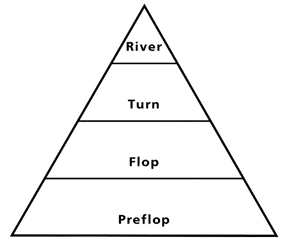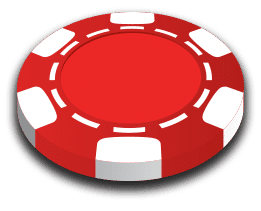This is a question I ask all my new students. First, I ask, “How do you do in the games you play? Do you win, lose, or roughly break-even?” Most say they win in the games they currently play. (In many cases this is an optimistic assessment.) Then comes the next question. “Where does the money come from? What actions do you take that cause you to win money over time?”
This is, perhaps surprisingly, a question most people can’t answer—at least not to my satisfaction. The most common answer new students give is that they fold. This answer comes in a number of varieties. Some students say they’re patient. Some say that they’re disciplined. Some say they play tight. These are all euphemisms for folding a lot.
Folding is, without a doubt, an important skill. But it doesn’t make you money. After all, when you fold, you win nothing. So, “I fold,” is not, to me, a satisfactory answer. If you’re often folding, how does money end up in your stack?

Where the money comes from is a critical question. What actions actually put money in your stack? You want to be able to answer as specifically as possible. You want to identify the behavior that puts money in your stack. Once you know what those actions are, you can take more of them, so more money will appear in your stack.
If you can answer my question only in generalities—i.e., you’re patient, or you choose your tables carefully—it will be hard for you to learn how to put money in your stack faster and better. If you don’t quite know what you’re doing right, then you can’t intentionally do more of it.
And folding ain’t it. Because I promise you: if you fold more and more, you won’t win more money.
Not to beat a dead horse, but where does the money come from? From this sentence to the end of the book, every word here is devoted to answering that question. What conditions must be present for money to accumulate? What specific actions can you take to grow your stack? And how can you take different actions to increase your stack as quickly as possible?
The Big Picture
Live cash games are a negative sum game. The house takes either a rake or a time charge.
In a game with a $4 rake that deals 25 hands an hour, roughly $100 leaves the table every hour. In a 10-handed game, this $100 is shared roughly equally among each player over time. So it costs about $10 a person each hour to play. Time charges (usually encountered at 5-10 and above) are typically a little more—perhaps $12 or $14 an hour.
Your job is to earn a profit through intentional, specific actions that totals more than the $10-to-$15 an hour it costs to play the game. These are actions you take that, generally, your opponents don’t take—or that they don’t take often enough.
This is the last time I will mention the rake. It’s true that in raked games (where the house takes the money directly from the pot), the amount can theoretically affect your decision in some hands. I recommend you ignore these considerations for two reasons:
- They arise so infrequently, we’re talking about the difference between $10 an hour and $10.50 an hour. You should be able to fade 50 cents an hour.
- The goal is to get good enough to play in 5-10 and higher games that use a time charge instead of a per-hand rake.
Unless you’re playing a game with an outrageous rake (say $10 a hand or higher), just pretend you’re paying a $10-an-hour time charge and don’t worry about it.
Okay. So poker in cash games is negative sum. You need to win at least $10 an hour from taking actions your opponents don’t take to at least break even. How do you do that? And who does that $10-plus come from?
This money comes from players who call or raise too much. It’s theoretically possible to make money from players who fold too much pre-flop (by stealing their blinds more than you should be able to). But in reality, no one you actually encounter at a poker table will make this error often enough for it to be profitable.
All the money you make playing poker at any level will come from players who call or raise too much. On average, they’re putting too much money into pots, and you’re taking from these pots more than your share.
As well, there are two ways to get money out of a pot. You can win it at showdown. Or you can bet and get everyone to fold. Your strategy to get more money will use both of these techniques repeatedly.
Think of it this way. It’s a 10-handed 1-2 no-limit hold ’em game. There is some perfect way to play this game. I don’t know what it is—no one does. No one’s even close to figuring out how to play this game perfectly. But let’s assume for a moment that there’s a player who knows how to play it perfectly.
Actually, let’s assume everyone knows how to play perfectly. So you have 10 perfect players pitted against one another. How does everyone do?
Everyone loses about $10 an hour.
Okay, that was easy. Now let’s consider just one of these players again. What does this perfect strategy look like? Pretend you don’t know the first thing about poker. You’re just watching the game and trying to figure out what you can.
Pre-flop, the perfect player would put some money in the pot some percentage of the time—let’s say with A% of all possible hands. On the flop, the perfect player would put money in the pot with B% of hands, where B is less than A, because the perfect player sometimes folds.
On the turn, the perfect player would put money in the pot with C% of hands, where C is less than B.
On the river, the perfect player would put money in the pot with D% of all possible hands, where D is less than C.
Graphically, it looks like a pyramid.

The perfect player starts out with a bunch of hands. After each betting round, this set of hands gets trimmed down a bit. Finally on the river, the perfect player is left with just a relative few hands that withstood the action.
So these are the perfect percentages—A%, B%, C%, and D% for pre-flop, flop, turn, and river betting.
But wait. When we play with real people, we’re not in perfect land anymore.
Everyone you meet will play the game with one or more of their corresponding percentages higher than A%, B%, C%, or D%. In other words, at least one of their betting percentages (and usually more than one) will be too high.
The difference between a player’s actual percentage, and a perfect percentage, represents extra hands this player is willing to play. These extra hands are bad hands. They have to be bad, by definition. If they weren’t bad, then they would be hands the perfect player was willing to play.
This is where the money comes from. When a player puts money into the pot with extra bad hands beyond the perfect percentage, they’re making that money available for you to win. Your goal is to gobble up as much of this money as you can. This is easier said than done. But the first step is to understand clearly what you’re trying to accomplish.
The money available to a player winning long term comes from other players’ willingness to put money into the pot with bad hands that a perfect player would not play.
You might believe the way to get this money is to outfold the competition. They’re putting money in with bad hands. So if you just fold those same bad hands when you get them, you’ll win.This is a good insight. But it’s not that simple.
Digging this? Then pick up the entire book today and let Ed teach you how to work your way from $1/$2 to $5/$10 (and beyond). Your bankroll will thank you ♥


